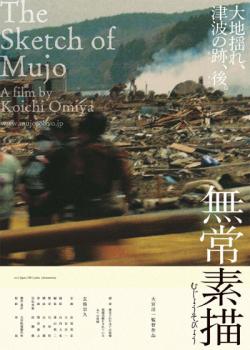Sketch of Mujo (無常素描)

Directed by Koichi Omiya (大宮浩一), 2011, 75 minutes
Review by Susan Meehan
This documentary is the first to have been made in the aftermath of the earthquake and tsunami which wrecked the Tohoku region of northeastern Japan on 11 March 2011. Tohoku is the land of Omiya’s birth and his parents’ home so the disaster particularly affected him.
Omiya defines “mujo” [無常] as a Buddhist concept conveying impermanence or transience. The Japanese often resort to this idea to alleviate the sadness of death and separation and to remind themselves that this world is but a stepping stone on the way to nirvana.
This heart-breaking and beautifully shot documentary shows scene upon scene of devastation in North East Japan. The eerie sound of crows in the background remind one of the immense death toll wreaked upon Tohoku. Within the scenes of rubble recognisable objects occasionally appear; a plastic bottle of ‘ume’ (‘pickled plums’) pokes through the dereliction and in the debris by the coast every now an almost intact house appears, highlighting the sheer level of destruction.
Omiya intersperses the scenes of devastation with those of survivors. An old woman is shown looking through a photo album which she has salvaged. “It’s our history,” she says. “We are coming to an end,” she continues and laughs with tears in her eyes.
A monk, reflecting on the disaster and the noble reaction and stoicism of the people of Tohoku, says that the people of North East Japan have never basked in the nation’s wealth and that is why they are so modest. “It is important.” he says, “to protect and nurture those disappearing virtues.” “The inhabitants of Tohoku realise they can’t beat nature and that sometimes the gods rage. Maybe we have erred on the wrong path.”
Further testifying to the steadfastness and lack of self-pity of those affected by the earthquake and tsunami, a young, bright woman is interviewed – she can’t leave her hometown – she loves the sea, “It is beautiful,” she remarks.
We encounter evacuation centres piled high with blankets and mattresses and replete with kettle, kerosene stoves and bright, young, spirited boys and older people. We meet a 98-year-old woman who has to rev herself up on a daily basis in order to keep going.
The monk appears again and this time talks about Laos where bridges are washed away every year. They are not built to resist; this fleeting existence encapsulates “mujo” – nothing is permanent, nothing stays the same.
I was unsure when the documentary was made but there are distinctive clues towards the end as we see carp streamers flying in the wind indicating it is around the time of the boys’ day celebration on 5 May and a few daffodils growing out of the mud. I wonder how the people of Tohoku are coping this winter.
Sketch of Mujo ends with a shot of the young woman who loves the sea resolutely standing, basked in light. We also see an endless queue of cars (ferrying people to “hanami” or celebrations under the cherry tree blossoms I wondered) motionless under the cherry tree blossoms swaying in the wind – the symbol, par excellence, of the transitory nature of life.
This film was shown at the Premiere Japan 2011 event at the Barbican.

